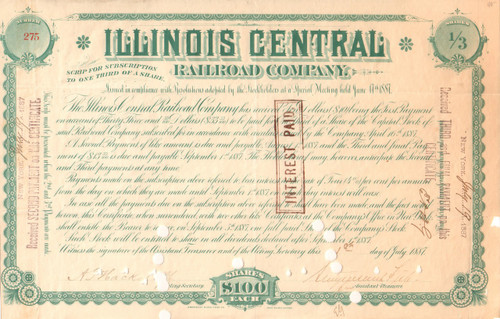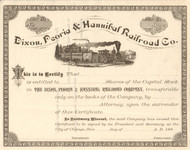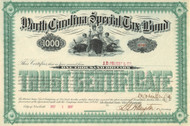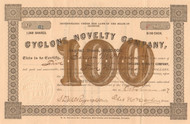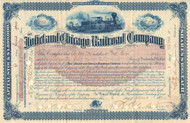Categories
Categories
- Home
- Railroad
- 1800's Railroads
- Illinois Central Railroad subscription of shares 1887
Illinois Central Railroad subscription of shares 1887
Product Description
Illinois Central Railroad subscription scrip for one third of a share 1887
Uncommon and older Illinois Cnetral RR piece. Great ornate border and unusual share amount of 1/3 in the upper right. Dated 1887.
The Illinois Central Railroad (reporting mark IC), sometimes called the Main Line of Mid-America, is a railroad in the central United States, with its primary routes connecting Chicago, Illinois, with New Orleans, Louisiana, and Mobile, Alabama. A line also connected Chicago with Sioux City, Iowa (1870). There was a significant branch to Omaha, Nebraska (1899), west of Fort Dodge, Iowa, and another branch reaching Sioux Falls, South Dakota (1877), starting from Cherokee, Iowa. The Sioux Falls branch has been abandoned in its entirety. The Canadian National Railway gained control of the IC in 1998.
The Illinois Central was chartered by the Illinois General Assembly on February 10, 1851. Senator Stephen Douglas and later President Abraham Lincoln were both Illinois Central men who lobbied for it. Douglas owned land near the terminal in Chicago. Lincoln was a lawyer for the railroad. Upon its completion in 1856 the IC was the longest railroad in the world. Its main line went from Cairo, Illinois, at the southern tip of the state, to Galena, in the northwest corner. A branch line went from Centralia, (named for the railroad) to the rapidly growing city of Chicago. In Chicago its tracks were laid along the shore of Lake Michigan and on an offshore causeway downtown, but land-filling and natural deposition have moved the present-day shore to the east.
In 1867 the Illinois Central extended its track into Iowa, and during the 1870s and 1880s the IC acquired and expanded railroads in the southern United States. IC lines crisscrossed the state of Mississippi and went as far as New Orleans, Louisiana, to the south and Louisville, Kentucky, in the east. In the 1880s, northern lines were built to Dodgeville, Wisconsin, Sioux Falls, South Dakota, and Omaha, Nebraska. Further expansion continued into the early twentieth century.
On August 10, 1972, the Illinois Central Railroad merged with the Gulf, Mobile and Ohio Railroad to form the Illinois Central Gulf Railroad (reporting mark ICG). On October 30 that year the Illinois Central Gulf commuter rail crash, the company's deadliest, occurred.
At the end of 1980 ICG operated 8,366 miles of railroad on 13,532 miles of track; that year it reported 33,276 million ton-miles of revenue freight and 323 million passenger-miles. Later in that decade, the railroad spun off most of its east-west lines and many of its redundant north-south lines, including much of the former GM&O. Most of these lines were bought by other railroads, including entirely new railroads such as the Chicago, Missouri and Western Railway, Paducah and Louisville Railway, Chicago Central and Pacific Railroad and MidSouth Rail Corporation.
In 1988 the railroad's then-parent company IC Industries spun off its remaining rail assets and changed its name to the Whitman Corporation (which became PepsiAmericas in 2000 and was acquired outright by PepsiCo in 2010). On February 29, 1988, the newly separated ICG dropped the "Gulf" from its name and again became the Illinois Central Railroad.
On February 11, 1998 the IC was purchased by the Canadian National Railway with the integration of operations beginning on July 1, 1999.
The Illinois Central was a major carrier of passengers on its Chicago to New Orleans mainline and between Chicago and St. Louis. IC also ran passengers on its Chicago to Omaha line, though it was never among the top performers on this route. Illinois Central's largest passenger terminal, Central Station, stood at 12th Street east of Michigan Avenue in Chicago. Due to the railroad's north-south route from the Gulf of Mexico to the Great Lakes, Illinois Central passenger trains were one means of transport during the African American Great Migration of the 1920s.
Illinois Central's most famous train was the Panama Limited, a premier all-Pullman car service between Chicago, St. Louis, Missouri, and New Orleans. In 1967, due to losses incurred by the operation of the train, the Illinois Central combined the Panama Limited with a coach-only train called the Magnolia Star. On May 1, 1971 Amtrak took over the operation of the service, but shortly afterward dropped the name in favor of the City of New Orleans, a daytime streamlined coach train that had been operated by the Illinois Central whose name was popularized by a song written by Steve Goodman and performed by Arlo Guthrie: Willie Nelson's recording of the song was #1 in 1984. Illinois Central ran several other trains along the main route including The Creole and The Louisiane.
The Green Diamond was the Illinois Central's premier train between Chicago, Springfield and St. Louis. Other important trains included the Hawkeye which ran daily between Chicago and Sioux City and the City of Miami eventually running every other day between Chicago and Miami via the Atlantic Coast Line, the Central of Georgia Railroad and Florida East Coast Railway. The Illinois Central was always a major Chicago commuter line operating electrified trains from its Michigan Avenue stations to the southeast suburbs until this traffic was assumed by Metra.
After 1971 Amtrak operated the Panama Limited, later renamed City of New Orleans, over the Illinois Central mainline and the Shawnee between Chicago and Carbondale, Illinois. Amtrak presently runs three trains daily over this route, the City of New Orleans and the Illini and Saluki between Chicago and Carbondale. Another Illinois corridor service is planned for the former Black Hawk route between Chicago, Rockford and Dubuque. Amtrak, at the state of Illinois' request, did a feasibility study to reinstate the Black Hawk route to Rockford and Dubuque. Initial capital costs range from $32 million to $55 million, depending on the route. Once in operation, the service would require roughly $5 million a year in subsidies from the state. On December 10, 2010, IDOT announced the route choice for the resumption of service to begin in 2014 going over mostly CN railway.
 Loading... Please wait...
Loading... Please wait... 
